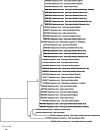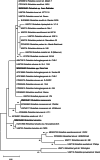Vector-borne pathogens in dogs of different regions of Iran and Pakistan
- PMID: 33506332
- PMCID: PMC8599219
- DOI: 10.1007/s00436-020-06992-x
Vector-borne pathogens in dogs of different regions of Iran and Pakistan
Abstract
Canine vector-borne diseases (CVBDs) are highly prevalent in tropical and subtropical countries, mainly due to favorable climate conditions and reduced adoption of preventive measures. This study aimed to provide a comprehensive overview on the prevalence of CVBDs in Iran and Pakistan where limited data are available. Blood samples were collected from 403 dogs from six provinces in Iran and Pakistan to assess the presence of pathogen DNA (i.e., Anaplasma spp., Coxiella burnetii, Ehrlichia spp., Rickettsia spp., Babesia spp., Hepatozoon spp., filarioids, and Leishmania spp.). Sera were also screened by an immunofluorescence antibody test for the detection of antibodies against Leishmania infantum. In total, 46.9% of dogs scored positive to Hepatozoon canis being the most frequently detected (41.4%), followed by Anaplasma platys (6.4%), Ehrlichia canis (3.4%), Rickettsia spp. (2.2%), Babesia vogeli (1.0%), and L. infantum (0.3%). A seroprevalence of 9.6% to anti-L. infantum IgG was also recorded. Data reported herein demonstrate that dogs from Iran and Pakistan are at a high risk of CVBDs, particularly of canine hepatozoonosis. Effective control strategies are advocated for minimizing the risk of infection in animals and humans, also in consideration of the zoonotic potential of some pathogens detected.
Keywords: Anaplasma platys; Canine vector-borne pathogens; Ehrlichia canis; Hepatozoon canis; Iran; Leishmania infantum; Pakistan; Rickettsia spp..
© 2021. The Author(s).
Conflict of interest statement
The authors declare that they have no conflict of interest.
Figures



References
-
- Ahmad AS, Rashid I, Ashraf K, et al. Molecular occurrence of canine babesiosis in rural dog population in Pakistan. Trop Biomed. 2018;35:593–603. - PubMed
-
- Akhtardanesh B, Ghanbarpour R, Blourizadeh H. Serological evidence of canine monocytic ehrlichiosis in Iran. Comp Clin Pathol. 2010;19:469–474. doi: 10.1007/s00580-009-0889-5. - DOI
-
- Akhtardanesh B, Saberi M, Nurollahifard SR, Aghazamani M. Molecular detection of Babesia spp. in tick-infested dogs in southeastern Iran. J Dis Glob Heal. 2016;8:72–77.
-
- Alborzi AR, Avizeh R, Mosallanejad B et al (2013) Babesia infection in urban and rural dogs in Ahvaz district, Southwest of Iran. Arch Razi Inst 68:37–42. 10.7508/ari.2013.01.006 - PubMed
MeSH terms
Supplementary concepts
LinkOut - more resources
Full Text Sources
Other Literature Sources
Miscellaneous

